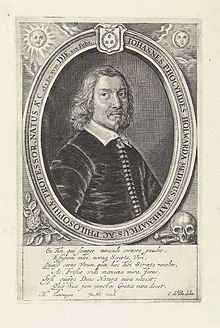
Johannes Phocylides Holwarda (Jan Fokkesz, Jan Fokker, Johann Holwarda, Johannes Fokkes Holwarda, Jan Fokkens Holwarda, Jan Fokkes van haylen) (February 19, 1618—January 22, 1651) was a Frisian astronomer, physician, and philosopher. He was a professor of philosophy at the University of Franeker from 1639 to 1651.
Born in Holwerd, he is best remembered for his discovery of the length of Mira's (Omicron Ceti's) varying appearance cycle. In a systematic study in 1638, he found that Mira disappeared and reappeared in a varying cycle of about 330 days.
Holwarda was also a supporter of "atomism". His Philosophia Naturalis, seu Physica Vetus-Nova, published posthumously in 1651, defines matter and form: matter is extended and divided into atoms while form is the texture of atoms. According to Phocylides, bodies are formed from atoms and a lack of atoms. Atoms, which he distinguished as simple or compound, are solid corpuscles that receive motion directly from God.
The lunar crater Phocylides is named after him.
Notes
- Hockey, Thomas, ed. (2009). The Biographical Encyclopedia of Astronomers. Springer Publishing. ISBN 978-0-387-31022-0. Retrieved August 22, 2012.
- Pieter Willem van der Horst, The Sentences of Pseudo-Phocylides (Brill, 1978), 63.
- "Holwarda, Johannes Phocylides". Archived from the original on 2016-03-03. Retrieved 2007-10-24.
- Mira, Omicron Ceti Archived 2007-10-24 at archive.today
- Antonio Clericuzio, Elements, Principles and Corpuscles: A Study of Atomism and Chemistry in the Seventeenth Century (Springer, 2001), p. 187.
- the-moon » Phocylides
This article about a Dutch scientist is a stub. You can help Misplaced Pages by expanding it. |
This European astronomer–related article is a stub. You can help Misplaced Pages by expanding it. |